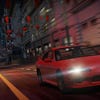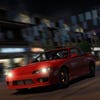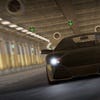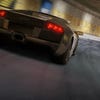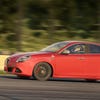Shift 2: Unleashed
"Our opposite is Gran Turismo."
"This is our own category," he laughs. "We don't want to play in the simulation sandbox, but saying that, the game is still based on a real world force physics simulator. So at the base of it, it has realistic physics: check the box.
"But that alone doesn't give us a Need for Speed experience: something that 95 per cent of the population will experience with the most rudimentary, dumbed-down control device you could put on top of that physics model - the normal controller. We have to create lots of layers of presentation and action and visuals and tutorials to make this approachable.
"Our opposite is Gran Turismo," he continues. "We don't need to get into an exhaustive chat about the comparisons, because for us there isn't one. They are a scientific model simulation experience, we are an authentic racing experience. Race day attitude, race day atmosphere, race day excitement. That's a videogame to us. When you have to play with a controller, that's what we think the game should be.
"Now, get behind a [force feedback steering set-up], and the game definitely performs like a simulation would, but those visual cues, those visual elements: that's all icing, all set-dressing. In the videogame industry, you don't create an FA-certified flight sim, because when you do that kind of flight sim, you don't get to have a dog fight."
On top of all that, of course, the team's layering Need for Speed's newest – and perhaps greatest – weapon: Autolog, the streamlined combination of leaderboard, progress tracker, and grudge-baiting social network.
"Autolog is such a simple mechanic," smiles Abney. "It's now Need for Speed DNA, and at the root of it is very basic standard features, but those features will always change depending on the design. So you'll see it in Hot Pursuit, and it's very arcade-focused, very narrow, very simple. Maybe it's tracking ten things.
"For a track-based authentic racing simulation game like Shift 2? Suddenly, it's tracking one hundred things. The level of micro-data management that these players want to see and that we can accumulate means that we have the ability to surface much more data, and that helps when we're pushing recommendations to you based on your performance.
"It's the same devices at play, but Shift 2 has depth and complexity that Hot Pursuit doesn't need, so we capture track-based stuff a lot more: corner mastering, segment mastering, track mastering, the car modifications, nitrous versus non-nitrous. The granularity of information is just that much deeper."
All of this – the action-oriented simulation set-up, the quasi-Pokémon Gym structure, and the endless taunting siren song of Autolog – would be worth little, of course, if the racing was hideous. But it's in the moment-to-moment battling that Shift 2 seems to be at its most comfortable, delivering staggeringly pretty action from a dynamic, eye-watering in-car viewpoint.
Tearing around a circuit threaded through the middle of Shanghai is both energising and panic-inducing, and the game's preoccupation with night events only serves to make things more intense.
If you thought more authentic driving experiences made for less dramatic racing, then, this is the game that might change your mind. And if you thought Hot Pursuit was the only trick Need for Speed had up its sleeve, prepare to be surprised.

